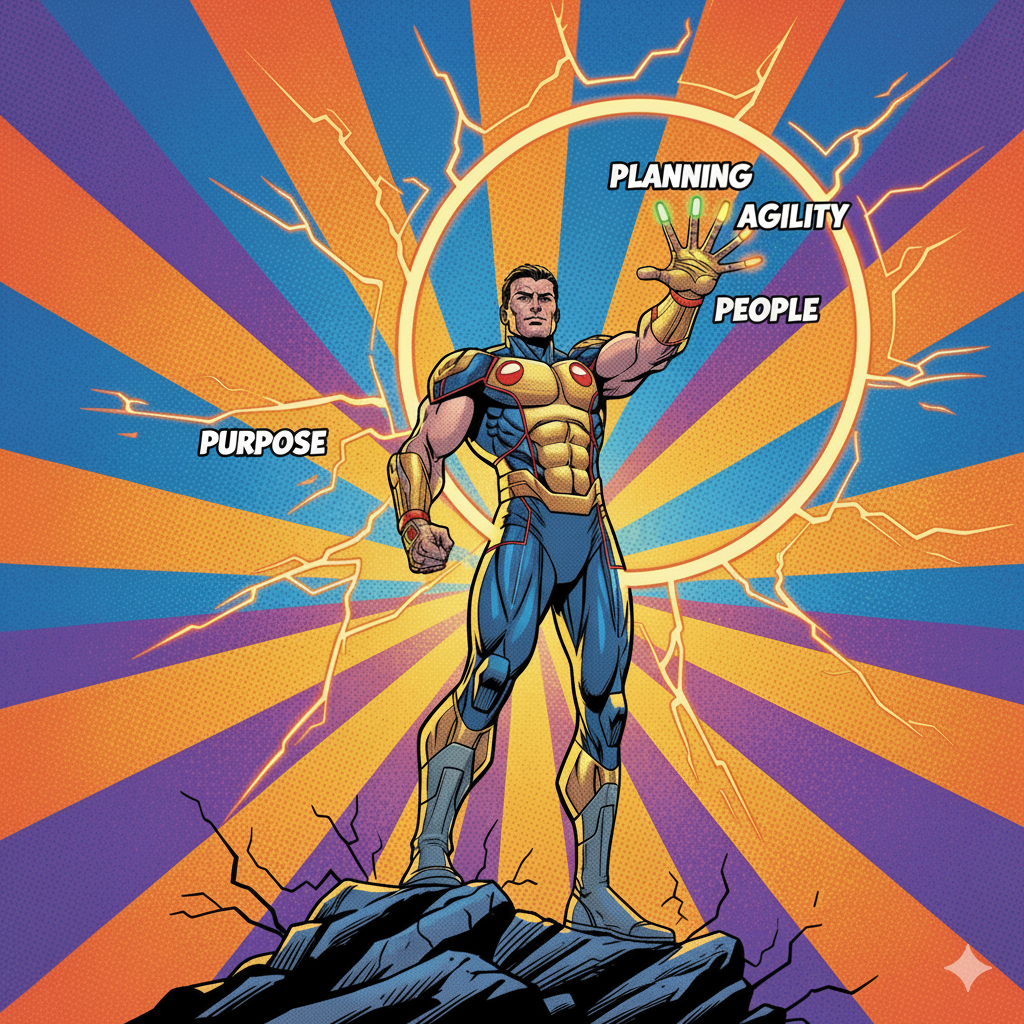Five Pillars · Practical Guardrails
Start Stacking Wins With the Five Pillars
You know the basics. However, knowing is not finishing. Therefore, this guide gives you a simple system for busy days. Moreover, it still works when motivation fades. As a result, you keep shipping.
Why Progress Stalls (And How to Unstick It)
Progress rarely fails for lack of knowledge. Instead, it fails when structure breaks. Consequently, good intentions get crowded out. Meanwhile, urgent tasks take over.
The Five Pillars—Purpose, Planning, Psychological Agility, People, and Persistence—fix that. Purpose points the way. Planning protects time for what matters. Additionally, agility safeguards momentum when life shifts. People raise or lower your standards. Finally, persistence compounds small wins. In short, the pillars keep you moving.
OutcomeBy the end, you will have a daily reset, a plan for obstacles, and a checklist that saves in your browser. Consequently, execution gets easier.
Five Common Traps (And the Fast Fix)
›Trap 1 — Purpose Becomes a Poster
Symptom
The words exist. Even so, choices ignore them. Therefore, your day fills with noise.
Fix
Write one line of purpose each morning. Then apply a two-question gate: Does this serve the purpose? What would serve it better? As a result, time follows meaning.
›Trap 2 — Beautiful Plans, No Follow-Through
Symptom
Heavy systems collapse on low-energy days. Consequently, tasks drift.
Fix
Plan lightly. Each evening, set three specific tasks in two minutes. Additionally, anchor default blocks. Thus, structure survives chaos.
›Trap 3 — “Flexible” Means Avoiding Hard Work
Symptom
Priorities shift, yet bottlenecks remain. Therefore, momentum stalls.
Fix
Pre-decide responses to likely obstacles. Moreover, pause before reacting. Consequently, agility serves the goal, not comfort.
›Trap 4 — Your Circle Normalizes Drift
Symptom
Low standards spread. Meanwhile, accountability fades. Eventually, results follow.
Fix
Audit your circle. Then spend more time with people who lift you. Share weekly proof of progress. Consequently, standards rise.
›Trap 5 — Intensity Replaces Consistency
Symptom
Big bursts look strong. However, they do not compound.
Fix
Use micro-goals and the Never Miss Twice rule. Additionally, track visually. Thus, rhythm stays intact.
The Lightweight Playbook
1) Purpose: Decide What Today Is For
Clarity cuts friction. Because attention is limited, pick one outcome for the day. For example, “Deliver a clean draft of the proposal.” Then let that choice guide each “yes.”
2) Planning: Turn Goals Into Time
Goals inspire. Calendars deliver. Therefore, schedule your top three tasks. Keep blocks short and specific. Additionally, defend the first block. Consequently, you start fast.
3) Agility: Expect Change and Adjust
Life moves. Markets shift. Even so, momentum can continue. Pre-plan one obstacle and your response. Replace “I failed” with “I learned.” As a result, you recover quickly.
4) People: Engineer the Room
Habits spread. Standards do too. Therefore, report progress to a supportive peer each week. Meanwhile, limit recurring down-drag time. Consequently, your baseline rises.
5) Persistence: Win the Week
Missing once is normal. Missing twice forms a pattern. Thus, track one habit with a simple streak. Additionally, keep micro-goals small. In short, consistency beats intensity.
Daily Reset: Five Steps in Five Minutes
Case Study: Same Talent, Different System
Person A — Motivation First
- Purpose feels vague. Consequently, decisions drift.
- Plans change daily. Therefore, time blocks vanish.
- Setbacks cause long gaps. Momentum dies.
- Peers normalize delay. Accountability drops.
- Progress arrives in bursts, then disappears.
Person B — Pillars First
- One-line purpose guides choices.
- Three tasks scheduled the night before.
- Obstacles expected. Responses pre-decided. Therefore, speed returns.
- Weekly updates shared with a supportive peer.
- Consistency tracked. Small wins compound.
After five years: Person A remains stuck. Meanwhile, Person B grows steadily. Thus, the difference is not potential. Instead, it is the system each person runs.
Applying the Pillars to Money
- Purpose gives money meaning. Otherwise, wealth feels empty.
- With planning, income turns into progress. Without it, savings slip away.
- Agility cushions shocks. Therefore, one setback does not erase gains.
- Your people shape habits. Consequently, the wrong circle drains your finances.
- Through persistence, compounding finally works in your favor.
ThereforeFinancial success is not only about earning more. It is also about systems that keep and grow what you earn.
Quick Answers to Common Questions
What if I miss the reset?
Begin again at the next block. Because the steps are small, recovery is easy. Additionally, apply the Never Miss Twice rule.
When do results show?
Usually within weeks. However, benefits start on day one: less friction and more clarity. As a result, output rises.
Do I need all five pillars?
Each pillar supports the rest. For example, planning without persistence fades. Likewise, persistence without purpose feels empty. Thus, integration matters.
Action Plan: Start Today
- Write a one-line purpose for the next 24 hours.
- Schedule three specific tasks for tomorrow.
- Pre-plan one obstacle and your response.
- Message a supportive peer with a short update.
- Track one daily habit and apply Never Miss Twice.
Conclusion: Build Guardrails, Not Guilt
Perfect days are rare. Fortunately, you do not need them. With the Five Pillars, you keep moving even when life shifts. Therefore, start with one guardrail now. Add another next week. Meanwhile, track one habit. Soon, momentum feels normal. Consequently, the scoreboard will catch up.



